Art of Interior Design: Specialist Meets S&R Evermay Awardee
By • November 30, 2023 0 2395
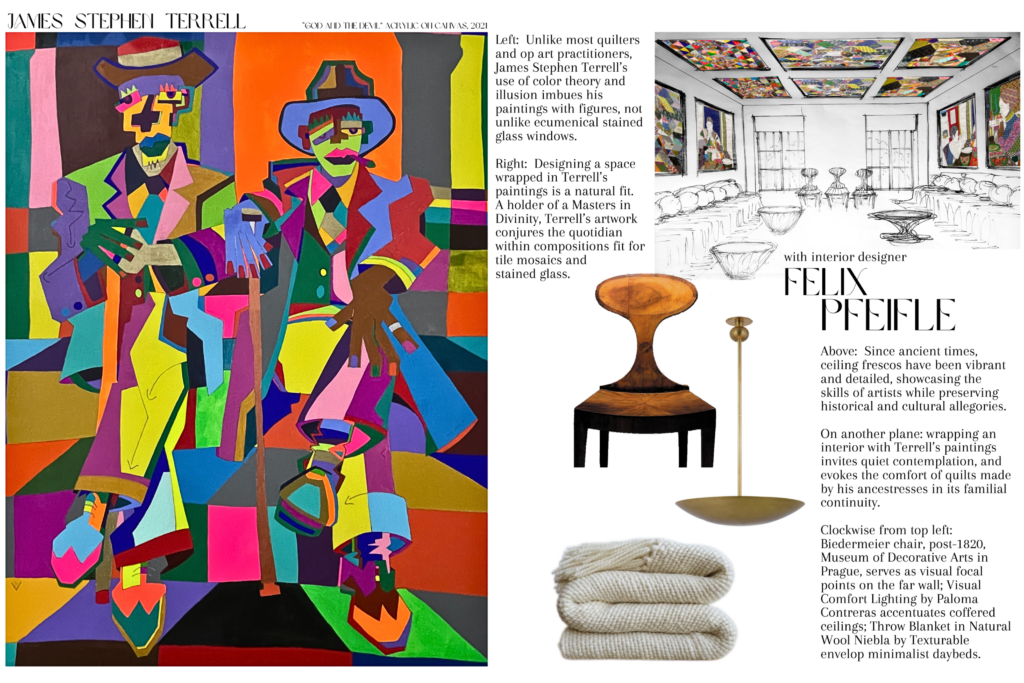
By Kobi Carter Eidman
In the first of our series about Georgetown’s S&R Evermay Washington Award recipients, The Georgetowner’s Business Development and Community Partnerships initiative spotlights award-winning artist James Stephen Terrell in collaboration with Fulbright Fellowship-recipient interior designer Felix Pfeifle, of the Felix Effect.
With a boldly creative and interdisciplinary approach, how might Terrell’s striking trans-African-inspired works be incorporated harmoniously into a beautiful interior living- scape?
S&R Evermay Awards
“Since its inception in 2001, S&R Evermay has supported the work of 80 artists through the Washington Award,” given in categories of Dance, Music, Visual Art and Interdisciplinary Art,” S&R Evermay said. “In a renewed commitment to supporting the artistic community of Washington D.C., the Washington Award is eligible to D.C. residents who prioritize social impact in their practice, working in the fields of visual art, interdisciplinary, music, or dance.” The annual Washington Award comprises two major prizes: a Cash Prize of four unrestricted grants of $15,000 in each artistic category; and, a Fillmore School Studio Prize to provide a full-year of free studio space usage at The Fillmore School in Georgetown for multiple artists.
Artist: James Stephen Terrell
One of this year’s winners, James Stephen Terrell, is pure Washingtonian. He grew up in the nation’s capital as the son of the Reverend Dr. James E. Terrell, fourteenth pastor of The Second Baptist Church, currently celebrating their 175th anniversary, and Judge Mary A. Terrell, the retired Clinton-appointed Associate Judge for the District of Columbia Superior Court. After completing his undergraduate studies at Howard University, James Stephen Terrell earned his M.F.A. from Parsons School of Design and his Masters of Divinity from Union Theological Seminary in New York City.
Terrell’s professional practice is closely intertwined with that of his wife, artist Zsudayka Nzinga. Both Nzinga and Terrell are Fillmore School Studio Prize Winners awarded through S&R Evermay’s coveted Washington Award in 2022 and 2023, respectively. Undoubtedly each other’s muse, their synergistic pieces are on view until Dec. 2 at the Art of Noize Gallery in the hip Petworth neighborhood of Washington, D.C. Through Dec. 30, Terrell also has a solo exhibition at the Priscilla R. Tyson Cultural Art Center in Columbus, Ohio, titled “A Collide of Scope.”
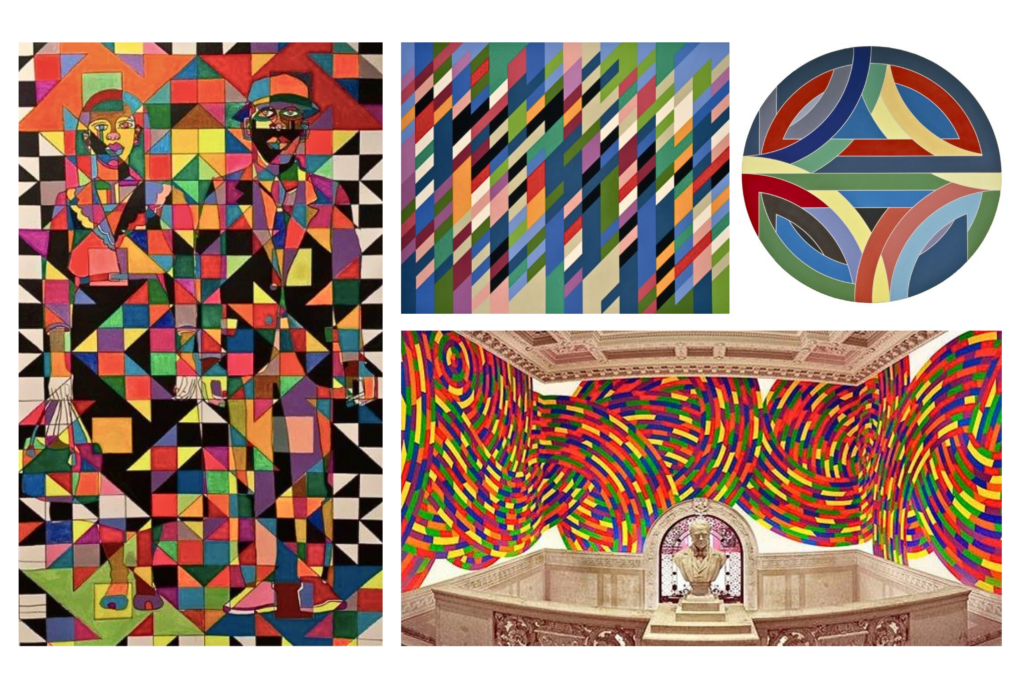
Terrell, Riley, Stella, LeWitt: Clockwise from Top Left: James Stephen Terrell, Matrimony, 2019. Bridget Riley, R.A., Debut, 1988. Frank Stella, Sinjerli Variation IV, 1968. Sol LeWitt Wall Drawing #1131, Whirls and twirls, 2004 in the lobby of the Wadsworth Atheneum Museum of Art, in Hartford, Connecticut.
Terrell’s kaleidoscopic explorations of vibrant colors are a testimony to his expertise in chromatics and geometric abstract art. He fuses techniques from Frank Stella and Joseph Albers’s color theory with eye-bending illusions of Sol LeWitt, Victor Vaserely, and Bridget Riley — all art titans of the late 20th century. Terrell’s philosophy is “Don’t compete with the television… Keep people, keep children, engaged. Offer another view.” Engagement is created through sustained looking. And for that, there is plenty, as his work contains worlds — not just patterns in shape and color.
Terrell’s use of historic and vernacular African masks speaks to the trans-African aesthetic championed by activists and artists, most notably Jeff Donaldson, who put the College of Fine Arts at Howard University on the international map. “Donaldson’s incorporation of geometric shapes, his color palette in TransAtlantic Dialogue,” Terrell explains, “The patterns are like jazz music if you break down the color wheel the way you break down the cycles of fourths in jazz music.”
Elements of quilting are also present as a tribute to those crafted by his grandmother Rebecca Paptaway Terrell from Birmingham, Alabama, and the women of Gee’s Bend, Alabama. Terrell’s artistry is a refreshing continuum of art intended to “unlock doors in minds and memories” firmly rooted within the traditions of ancient art forms. His ritualistic tapestries of life seamlessly blend figures into geometric compositions in the tradition of painted frescoes and tiled mosaics discovered from the first Egyptian Dynasty, the Roman and the Byzantine Empires.
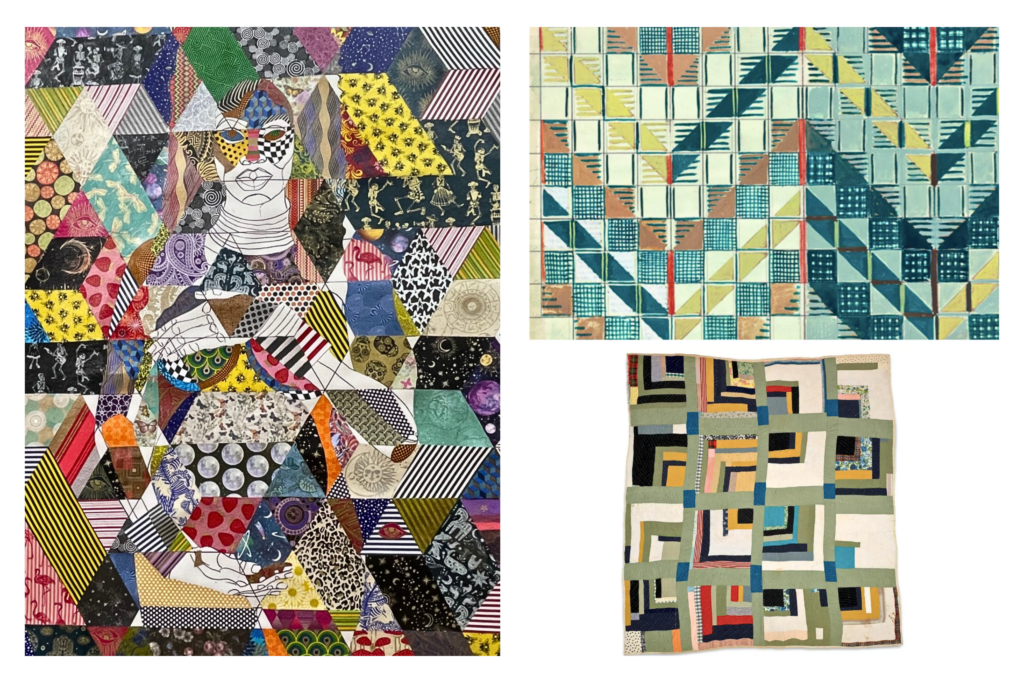
Terrell, Marx, Pettway: Clockwise from Top Left: James Stephen James, Mother of the Universe, 2023. Enid Marx, London Underground Study for Chevron, 1937. Martha Pettway, “Housetop”—”Half-Log Cabin” Variation, c. 1930s.
Interior Designer, Felix Pfeifle
We asked interior designer Felix Pfeifle of the Felix Effect to contribute a sketch of how Terrell’s work would best be showcased in a home of one of his illustrious clients. As a nod to Terrell’s rich background in theology and art history, Pfeifle began by positioning Terrell’s work within coffered ceilings to draw the viewer’s eyes upward. Originally created for engineering purposes, coffered ceilings have been implemented from ancient Greek and Roman times to modern municipal and residential structures to create architectural dimensionality and visual extravagance. To balance the masculine lines of the ceiling and wall grid pattern, Pfeifle then paired a trio of Biedermeier chairs with an exceptionally curved back. The chair’s ascending oval back forms a symbolic tree-of-life motif echoed in the curves and patterns of Terrell’s “Last Family Supper.” Both works gently remind us of life’s simultaneous branching out into future manifestations while being firmly rooted in substantive past traditions. Grounding the grandiosity of the coffered ceiling and paintings, Pfeifle lined the room with humble daybeds covered in natural fabrics, neutral colors, to create a space of unusual leisure to lift one’s gaze and experience calm contemplation.
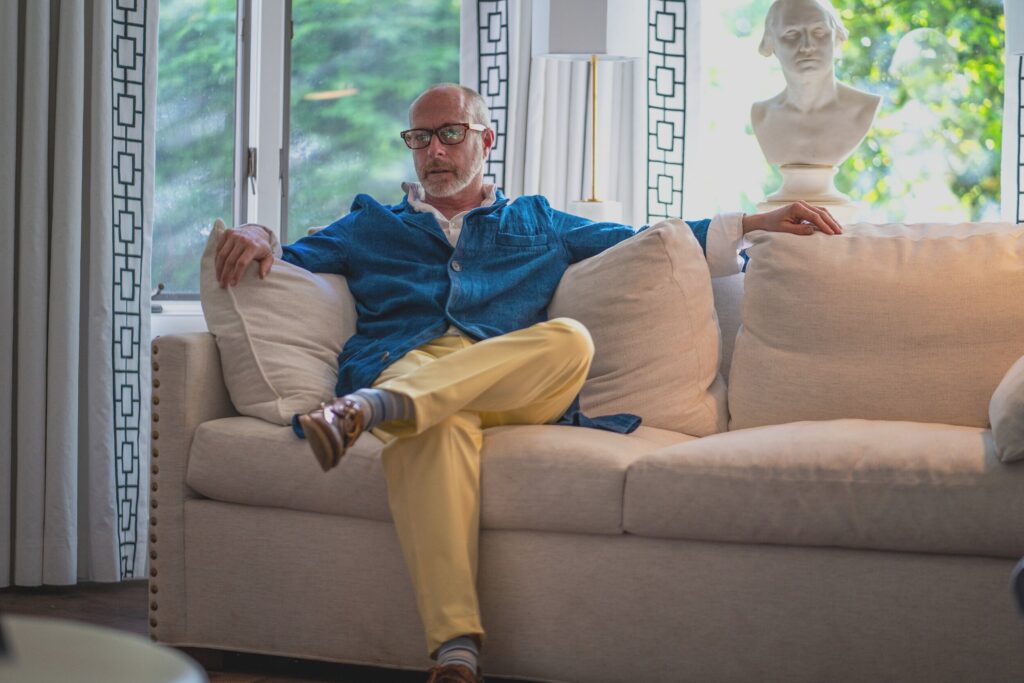
Director of the Felix Effect, Felix Etienne-Edouard Pfeifle, believes every client has an “inner-Medici.” Courtesy The Felix Effect.
Long before the Italian Renaissance, patrons of the arts commissioned interior frescoes and panels as powerful means to exhibit their taste, erudition, and social status. Frescoes were often used to depict religious, mythological, or historical scenes, signaling not only artistic refinement, but also the patron’s worldview and place in it. The entirety signaled, “This is who I am in the world.” The practice of commissioning art in this manner declined in the 19th century with the emergence of the art piece as a discrete object, free of personal attachment to the patron — the object often just a commodity.
Lost were the opportunities for one-of-a-kind painted frescoes or panels to enhance the aesthetic appeal and the historic significance of a residence or building while captivating art enthusiasts and history lovers alike. The art of lavishly investing in superior interior design, especially the commissioning of painted environments, elevates the structure, plays a crucial role in supporting artists, and entices discerning real estate buyers and art collectors alike.
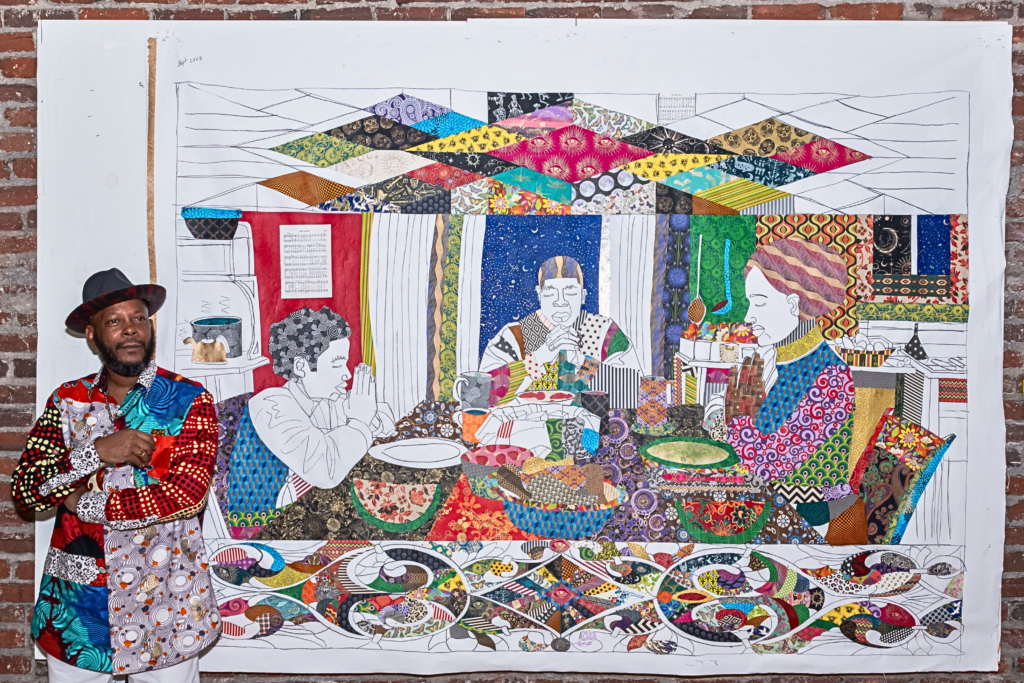
Artist James Stephen Terrell’s “Last Family Supper.” (2023) Photo by Joseph Edwards Photography.
In Pfeifle’s own words, “James Stephen Terrell’s work repositions art as part, or at least as extension of, the ritual of life. The quilt wraps us in its art while keeping us warm. The ceiling fresco expresses one’s Weltanschauung. The stained glass window instructs. Terrell’s work beckons us to look to the celestial contained in his art.” Pfeifle continues, “Such art becomes inseparable from the lives we lead. It dignifies the prosaic through poetics. In today’s terms, it’s ‘holistic’.” Wake up to it, walk into it, look up at it, wrap yourself in it: an interior for our times.
For more information, please visit TerrellArtsDC.com, SandRevermay.org, and TheFelixEffect.com. To find out more about The Georgetowner’s Business Development and Community Partnerships, please contact Kobi Carter Eidman at Kobi@Georgetowner.com.

